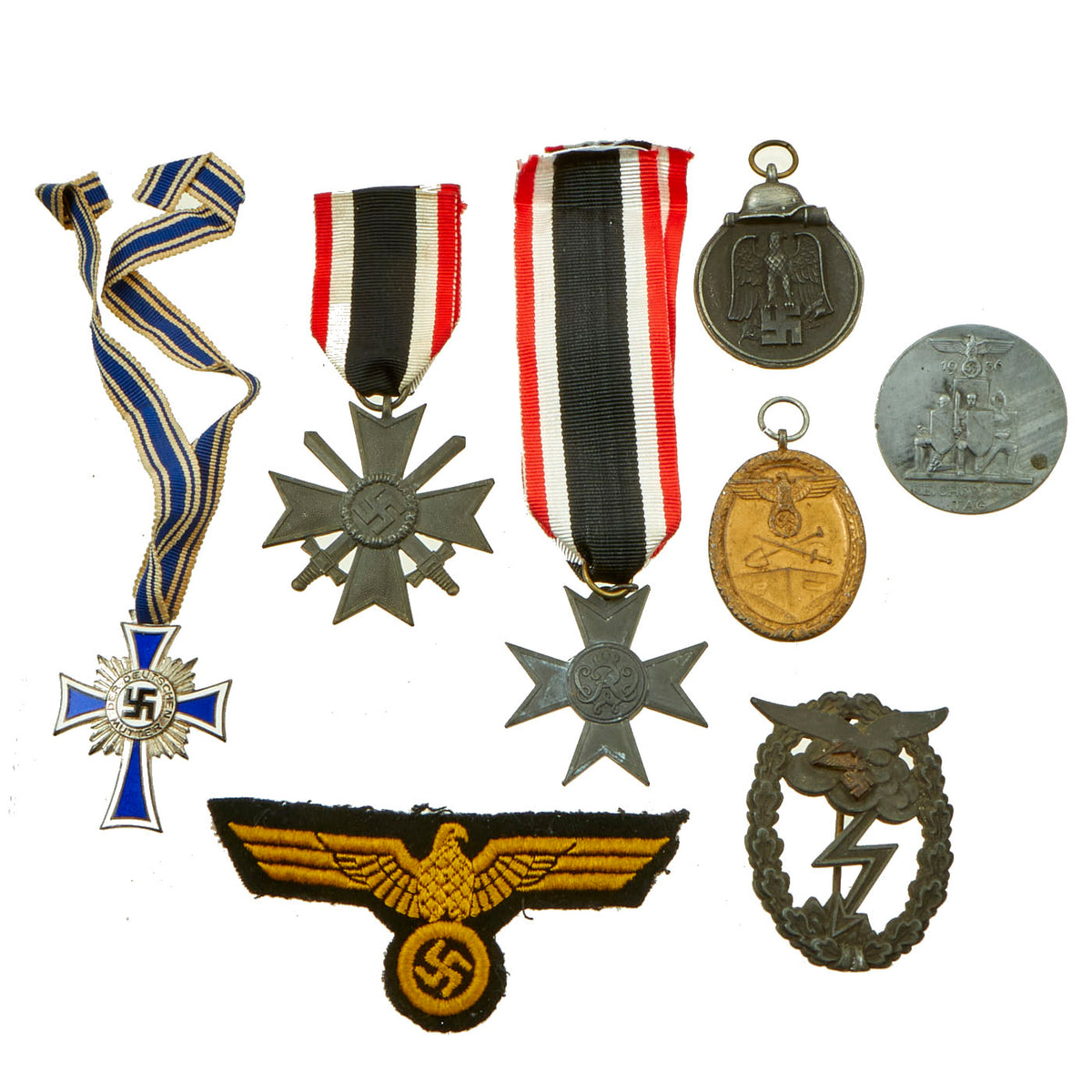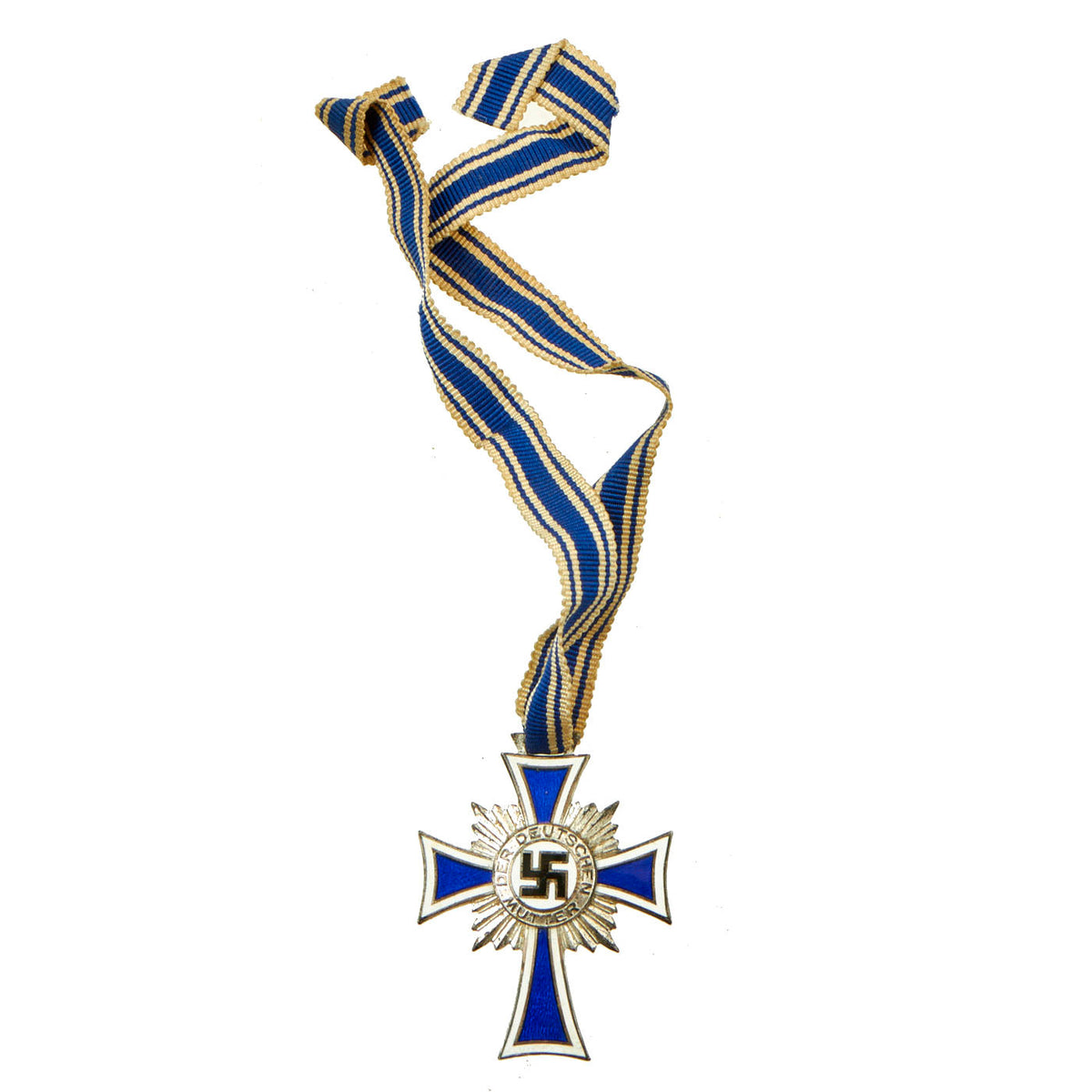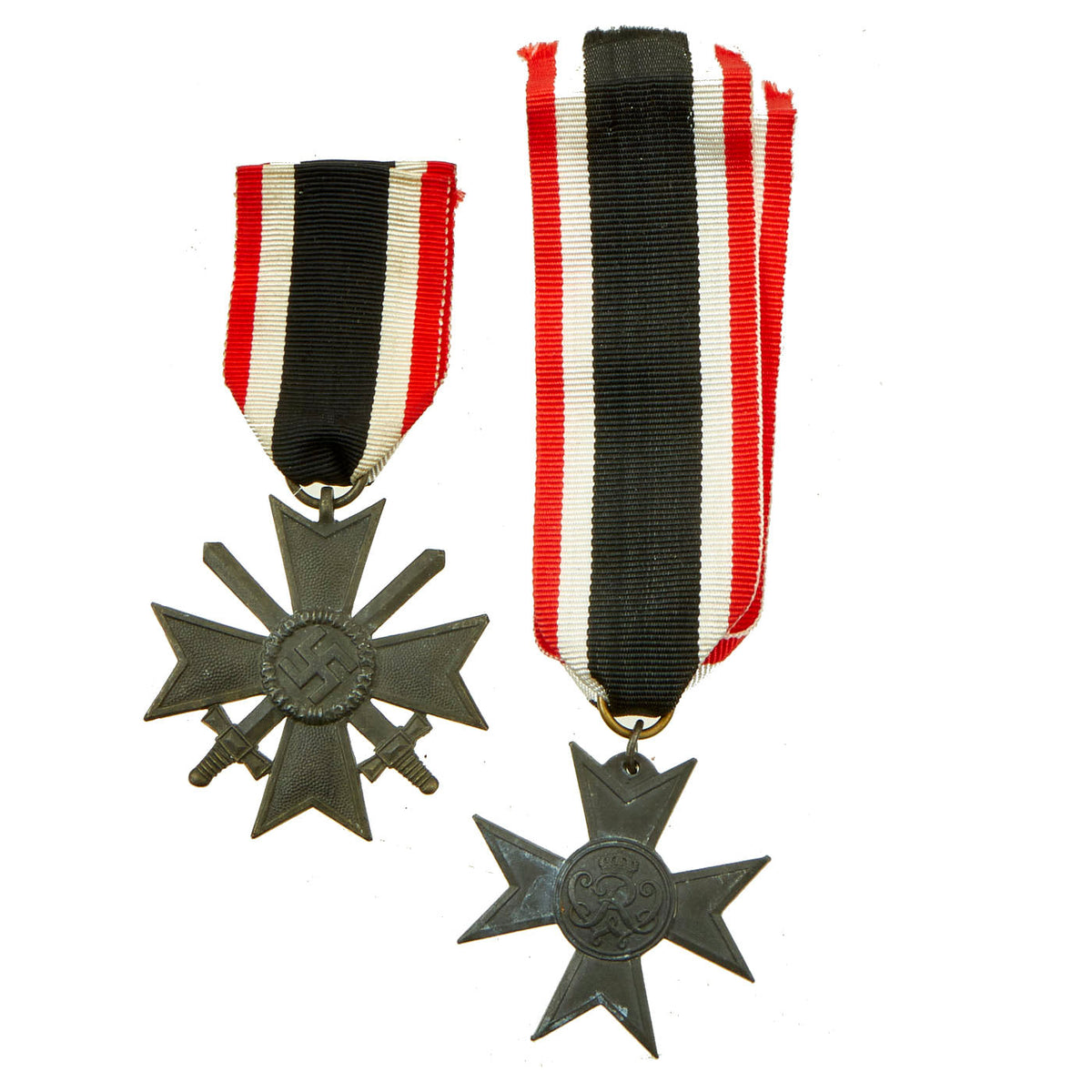Original German WWII Medal and Insignia Lot – 8 Items Original Items
$ 250,00 $ 100,00
Original Items: Only One Lot of 8 Available. This is a wonderful lot with a beautiful assortment of items. This is perfect for the younger collectors just starting out or the salty collectors wanting to add more items to their collection.
The items in this lot:
– West Wall Medal (No Ribbon): The West Wall Medal was a decoration of NSDAP Germany. It was instituted on 2 August 1939 and was given to those who designed and built the fortifications on Germany’s western borders, known as the Westwall or, in English, the Siegfried Line, between 15 June 1938 to 31 March 1939. On 13 November 1939 eligibility was extended to include servicemen of the Wehrmacht who served on the Westwall for at least ten weeks. In all 622,064 medals were awarded until 31 January 1941, when awards of the medal ceased. The medal was awarded in one class. It was struck in bronze. Its oval shape featured on the obverse (from bottom to top) a bunker, a crossed sword and shovel, and the German Eagle. The reverse bore the inscription “Für Arbeit zum Schutze Deutschlands” (For Work in the Defence of Germany). Both sides of the medal were edged with a wreath of oak leaves.
– KvK 2nd Class With Swords and Replaced Ribbon: The War Merit Cross was a state decoration of NSDAP Germany during World War II. By the end of the conflict it was issued in four degrees and had an equivalent civil award. A sanitized version of the War Merit Cross was reissued in 1957 by the Bundeswehr for its veterans.
This award was created by Adolf H in October 1939 as a successor to the non-combatant Iron Cross which was used in earlier wars (similar medal but with a different ribbon). The award was graded in the same manner as the Iron Cross: War Merit Cross Second Class, War Merit Cross First Class, and Knights Cross of the War Merit Cross. The award had two variants: with swords given to soldiers for exceptional service “not in direct connection with combat”, and without swords given to civilians for meritorious service in “furtherance of the war effort”. Recipients had to have the lower grade of the award before getting the next level.
– Imperial German WWI Merit Cross For War Aid (Incorrect Ribbon): The Merit Cross for War Aid was a war decoration of Prussia awarded during World War I. Instituted 5 December 1916, the cross was awarded for patriotic war aid service, without regard to status or rank.
The Merit Cross for War Aid is in the shape of a Maltese cross, typically found made of blackened Kriegsmetall alloy. The obverse of the cross bears a circular central medallion with the crowned cipher of King Wilhelm II. On the reverse the central medallion is inscribed FÜR KRIEGS-HILFSDIENST (For War Aid Merit) above an oak wreath. To the upper arm is attached a loop for suspension from its ribbon.
– 2nd Class Silver Mother’s Cross: This is a very nice example of The Cross of Honour of the German Mother or Mutterkreuz (Mother’s Cross) in silver (2nd class, Silver Cross: eligible mothers with six or seven children).
The award itself still has some of the original ribbon present, which is in solid condition. The front of the award still has all of the original enamel. Reverse of medal reads 16 December 1938, which is the date that the award was first established, along with AH’s Signature. The silver plating is overall patinated, giving it a great aged look.
– Luftwaffe Ground Combat Badge (Broken): In late 1941 the first Luftwaffe ground combat units were hastily formed to help replace the massive loss of men on the Eastern front, followed by the formation of the Brigade Meindl consisting of five Luftwaffe Field Battalions in February 1942. As a result of the formation of these new ground combat units, Reichsmarschall Hermann Göring established the Luftwaffe Ground Combat Badge on March 31, 1942, for award to all Luftwaffe personnel who had distinguished themselves in ground combat. Certain criteria had to be met for award of the badge with the main criteria being three separate ground combat actions.
The badge is a two piece, die struck zinc, solid backed award in the form of a burnished matte gray washed vertically oval oak-leaf wreath with separate silver washed Luftwaffe eagle superimposed to top, encompassing a burnished matte gray washed cloud and black washed lightning bolt. Silver wash is gone from the wreath and it has reverted back to a dark gray. Eagle was attached to the wreath by three dome headed rivets, unfortunately most of the eagle is broken and missing. Vertical barrel hinge pin back is intact. Almost all of the silver wash is missing.
– Eastern Medal (No Ribbon): The Eastern Medal, officially the Winter Battle in the East 1941–42 Medal, was a military award of the Wehrmacht which was created by ordinance of Adolf H on 26 May 1942.
The Eastern Medal was awarded to any member of the Wehrmacht and Waffen-SS “in recognition of experience in the struggle against the Bolshevik enemy and the Russian winter within the period from 15 November 1941 to 15 April 1942.” It was also awarded posthumously to any service member who died in the line of duty within the Soviet Union. It was wryly called the Frozen Meat Medal or the “Order of the Frozen Flesh”.
The Eastern Medal was designed by SS-Unterscharführer Ernst Krauit. Measuring 3.6 cm (1.4 in) in diameter, of (generally) zinc construction, the medal was given a gun-metal coloured coating. The concave obverse side features a national socialist eagle grasping a swas with laurel behind. The reverse features the text in capital letters: “WINTERSCHLACHT IM OSTEN 1941/42” (“Winter Battle in the East 1941-42”) featuring a crossed sword and branch below the text. A helmet and stick grenade below the medal loop as well as outer ring were finished in a polished silver effect. The medal measures approximately 44mm by 36mm.
– Kriegsmarine EM/NCOs Breast Eagle: Machine embroidered national eagle in golden yellow rayon thread on a black wool base.
– 1936 Reichsparteitag Tinnie: The 8th Party Congress was known as the “Rally of Honor” (Reichsparteitag der Ehre, September 8–14). The remilitarization of the demilitarized Rhineland in March 1936 constituted the restoration of German honor in the eyes of many Germans. It is constructed out of a die struck zinc-alloy base that has been silver gilded. The round shaped obverse depicts three kneeling warriors, with shields, protecting a plinth below a national eagle with outstretched wings clutching a wreathed swas within its talons and surrounded by “1936”, which is all above “Reichsparteitag”.
All items come ready for display.
Fast Shipping with Professional Packaging
Thanks to our longstanding association with UPS FedEx DHL, and other major international carriers, we are able to provide a range of shipping options. Our warehouse staff is expertly trained and will wrap your products according to our exact and precise specifications. Prior to shipping, your goods will be thoroughly examined and securely secured. We ship to thousands clients each day across multiple countries. This shows how we're dedicated to be the largest retailer on the internet. Warehouses and distribution centres can be located throughout Europe as well as the USA.
Note: Orders with more than one item will be assigned a processing date depending on the item.
Before shipping before shipping, we'll conduct a thorough inspection of the items you have ordered. Today, the majority of orders will be delivered within 48 hours. The delivery time will be between 3-7 days.
Returns
The stock is dynamic and we cannot completely manage it because multiple stakeholders are involved, including our factory and warehouse. So the actual stock may alter at any time. It's possible that you may not receive your order once the order has been made.
Our policy is valid for a period of 30 days. If you don't receive the product within 30 days, we are not able to issue a refund or an exchange.
You can only return an item if it is unused and in the same state as the day you received it. You must have the item in its original packaging.
Related products
Uncategorized
Angolan Rebel 1970s era 60mm Inert Display Mortar from Angolan Civil War Original Items
Uncategorized
Uncategorized
Uncategorized
Uncategorized
Uncategorized
Armored Burgonet Helmet & Polearm from Scottish Castle Leith Hall Circa 1700 Original Items
Uncategorized
Uncategorized
Australian WWII Owen MK1 Machine Carbine SMG Custom Fabricated Replica with Sling Original Items
Uncategorized
Uncategorized
Uncategorized
Uncategorized
Uncategorized
Uncategorized
Uncategorized













































































